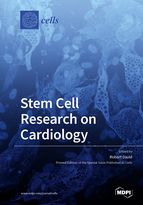Stem Cell Research on Cardiology
A special issue of Cells (ISSN 2073-4409). This special issue belongs to the section "Stem Cells".
Deadline for manuscript submissions: closed (29 February 2020) | Viewed by 80802
Special Issue Editor
Interests: cardiovascular diseases; pluripotent stem cells; ESCs; iPSCs; adult stem cells; cell replacement; direct reprogramming; cardiac regeneration; stem cell optimisation; cell targeting; sinus node; biological pacemaker; cell therapy; gene therapy; forward programming; organoid; disease-in-the-dish
Special Issues, Collections and Topics in MDPI journals
Special Issue Information
Dear Colleagues,
Cardiovascular diseases are the leading cause of death in the developed countries with very limited therapeutic options. A major cause lies in the very rstricted regenerative capacity of terminally differentiated cardiomyocytes post injury – therefore novel approaches toward cardiac regenerative therapy is highly desired. Following injury oft he myocardium, resident cardiac fibroblasts, representing over 50% of the cells in the heart, start to proliferate and produce extracellular matrix, which will ultimately leads to fibrosis and heart failure. A large number of preclinical and clinical trials have shown stem cell therapy to be a promising therapeutic approach for the treatment of cardiovascular diseases. Since the first transplantation into human patients, several stem cell types have been applied in this field, including bone marrow derived stem cells, cardiac progenitors as well as embryonic and induced pluripotent stem cells and their derivatives. In addition, the novel field of direct cardiac reprogramming brougt promising advances in vitro and in vivo, opening an additional future field for cardiovascular regenerative medicine. In order to optimize these approaches, it will be crucial to elucidate the underlying mechanisms mediating the beneficial effects of stem cell transplantation or direct reprogramming. Based on these mechanisms, scientists have begun to develop different improvement strategies to boost the potency of stem cell repair and to generate the "next generation" of cell based therapeutics.
The current Special Issue will accept original studies, reviews and technical reports in the field of cardiovascular stem cell biology and reprogramming, written by scientists active in the field.
Prof. Robert David
Guest Editor
Manuscript Submission Information
Manuscripts should be submitted online at www.mdpi.com by registering and logging in to this website. Once you are registered, click here to go to the submission form. Manuscripts can be submitted until the deadline. All submissions that pass pre-check are peer-reviewed. Accepted papers will be published continuously in the journal (as soon as accepted) and will be listed together on the special issue website. Research articles, review articles as well as short communications are invited. For planned papers, a title and short abstract (about 100 words) can be sent to the Editorial Office for announcement on this website.
Submitted manuscripts should not have been published previously, nor be under consideration for publication elsewhere (except conference proceedings papers). All manuscripts are thoroughly refereed through a single-blind peer-review process. A guide for authors and other relevant information for submission of manuscripts is available on the Instructions for Authors page. Cells is an international peer-reviewed open access semimonthly journal published by MDPI.
Please visit the Instructions for Authors page before submitting a manuscript. The Article Processing Charge (APC) for publication in this open access journal is 2700 CHF (Swiss Francs). Submitted papers should be well formatted and use good English. Authors may use MDPI's English editing service prior to publication or during author revisions.
Keywords
- Cardiovascular diseases
- Pluripotent stem cells
- ESCs
- iPSCs
- Adult Stem Cells
- Cell replacement
- Direct Reprogramming
- Cardiac regeneration
- Stem cell optimisation
- Cell Targeting







